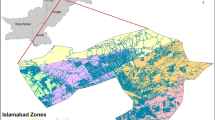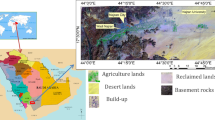Abstract
Urban expansion and unprecedented rural to urban transition, along with a huge population growth, are major driving forces altering land cover/use in metropolitan areas. Many of the land cover classes such as farmlands, wetlands, forests, and bare soils have been transformed during the past years into human settlements. Identification of the city growth trends and the impact of it on the vegetation cover of an area is essential for a better understanding of the sustainability of urban development processes, both planned and unplanned. Analyzing the causes and consequences of land use dynamics helps local government, urban planners, and managers for the betterment of future plans and minimizing the negative effects.
This study determined temporal changes in vegetation cover and built-up area in Istanbul (Turkey) using the normalized difference vegetation index (NDVI), soil-adjusted vegetation index (SAVI), and built-up area index (BUAI). The temporal data were based on Landsat 5 Thematic Mapper (TM) images acquired in June of 1984, 2002, 2007, 2009, and 2011. The NDVI was applied to all the Landsat images, and the resulting NDVI images were overlaid to generate an NDVI layer stack image. The same procedure was repeated using the SAVI and BUAI images. The layer stack images revealed those areas that had changed in terms of the different indices over the years. To determine temporal change trends, the values of 150 randomly selected control points were extracted from the same locations in the NDVI, SAVI, and BUAI layer stack images. The results obtained from these control points showed that vegetation cover decreased considerably because of a remarkable increase in the built-up area.








Similar content being viewed by others
References
Benkouider, F., Abdellaoui, A., Hamami, L., & Elaihar, M. (2013). Spatio temporal analysis of vegetation by vegetation indices from multi-dates satellite images: application to a semi arid area in ALGERIA. In Energy Procedia, 36, 667–675. doi:10.1016/j.egypro.2013.07.077.
Carlson, T. N., & Arthur, T. S. (2000). The impact of land use—land cover changes due to urbanization on surface microclimate and hydrology: a satellite perspective. Global and Planetary Change, 25(1–2), 49–65.
Coban, H. O., Koc, A., & Eker, M. (2010). Investigation on changes in complex vegetation coverage using multi-temporal Landsat data of Western Black Sea region—a case study. Journal of Environmental Biology, 31, 169–178.
Drummond, M. a., & Loveland, T. R. (2010). Land-use pressure and a transition to forest-cover loss in the eastern United States. Bioscience, 60(4), 286–298.
Gazioğlu, C., Alpar, B., Yücel, Z. Y., Müftüoğlu, A. E., Güneysu, C., Ertek, T. A., Demir, V., & Kaya, H. (2014). Morphologic features of Kapıdağ Peninsula and its coasts (NW-Turkey) using by remote sensing and DTM. International Journal of Environment and Geoinformatics, 1(1), 48–63.
Gazioğlu, C., Yücel, Z. Y., Burak, S. Z., Okus, E., & Alpar, B. (1997). Coastline changes and inadequate management between Kilyos and Karaburun shoreline. Turkish Journal of Marine Sciences, 3(2), 111–122.
Han, G. F., Xu, J. H., & Yuan, X. Z. (2008). Impact of urbanization on vegetation phenology in major cities in Yangtze River Delta region. The Journal of Applied Ecology, 19(8), 1803–1809.
Huete, A. R. (1988). A soil-adjusted vegetation index (SAVI). Remote Sensing of Environment, 25(3), 295–309.
Jung, A., Kardeván, P., & Tokei, L. (2005). Detection of urban effect on vegetation in a less built-up Hungarian City by hyperspectral remote sensing. Physics and Chemistry of the Earth, Parts A/B/C, 30(1), 255–259.
Kaya, S. (2007). Multitemporal analysis of rapid urban growth in Istanbul using remotely sensed data. Environmental Engineering Science, 24(2), 228–233. doi:10.1089/ees.2005.0040.
Kaya, H., & Gazioğlu, C. (2015). Real estate development at landslides. International Journal of Environment and Geoinformatics, 2(1), 62–71.
Kaya, S., Basar, U. G., Karaca, M., & Seker, D. Z. (2012). Assessment of urban heat islands using remotely sensed data. Ekoloji, 21(84), 107–113. doi:10.5053/ekoloji.2012.8412.
Kaya, S., Gazioğlu, C., Sertel, E., Şeker, D.Z., and Algancı, U., (2015). Rapid determination of land use/cover changes using data fusion. The 36th Asian Conference on Remote Sensing "Fostering Resilient Growth in Asia", Metro Manila, Filipinler, 19–23 October 2015.
Khan, M.H., Bryceson, I., Korine N. Kolivras, K.N., Fazlay Faruque, F., Rahman, M., and Haque, U., (2014). Natural disasters and land-use/land-cover change in the southwest coastal areas of Bangladesh. Regional Environmental Change, 241–50. doi:10.1007/s10113-014-0642-8.
Lambin, E. F., Geist, H. J., & Lepers, E. (2003). Dynamics of land-use and land-cover change in tropical regions. Annual Review of Environment and Resources, 28, 205–241.
Lambin, E. F., Turner, B. L., Geist, H. J., Agbola, S. B., Angelsen, A., Bruce, J. W., & Xu, J. (2001). The causes of land-use and land-cover change: moving beyond the myths. Global Environmental Change, 11, 261–269.
Li, S., Yang, S., Liu, X., Liu, Y., & Shi, M. (2015). NDVI-based analysis on the influence of climate change and human activities on vegetation restoration in the Shaanxi-Gansu-Ningxia Region. Central China, Remote Sensing, 7, 11163–11182. doi:10.3390/rs70911163.
Lu, L., Guo, H., Wang, C., Pesaresi, M., & Ehrlich, D. (2014). Monitoring bidecadal development of urban agglomeration with remote sensing images in the Jing-Jin-Tang area, China. Journal of Applied Remote Sensing, 8(1), 84592. doi:10.1117/1.JRS.8.084592.
Morawitz, D. F., Blewett, T. M., Cohen, A., & Alberti, M. (2006). Using NDVI to assess vegetative land cover change in central Puget Sound. Environmental Monitoring and Assessment, 114(1–3), 85–106. doi:10.1007/s10661-006-1679-z.
Musaoglu, N., Gürel, M., Ulugtekin, N., Tanik, A., & Seker, D. Z. (2006). Use of remotely sensed data for analysis of land-use change in a highly urbanized district of mega city, Istanbul. Journal of environmental science and health. Part A, Toxic/hazardous substances & environmental engineering, 41(9), 2057–2069.
Osgouei, P. E., (2015). Analysis of land cover/use change using Landsat 5 TM data and indices. Master Thesis, Istanbul Technical University, 86 p.
Piao, S., Fang, J., Zhou, L., Guo, Q., Henderson, M., Ji, W., Li, Y., & Tao, S. (2003). Interannual variations of monthly and seasonal normalized difference vegetation index (NDVI) in China from 1982 to 1999. Journal of Geophysical Research, 108, 14,4401. doi:10.1029/2002JD002848.
Ridd, M. K., & Liu, J. (1998). A comparison of four algorithms for change detection in an urban environment. Remote Sensing of Environment, 63, 95–100.
Rokni, K., Anuar Ahmad, A., Selamat, A., & Hazini, S. (2014). Water feature extraction and change detection using multitemporal Landsat imagery. Remote Sensing, 6(5), 4173–4189. doi:10.3390/rs6054173.
Saroglu, E, Bektas, F, Dogru, A.O., Ormeci, C., and Musaoglu, N., (2005). Environmental impact analyses of quarries located on the Asian side of Istanbul using remotely sensed data. XXIInd International Cartographic Conference, 9–16 July, Coruna, Spain (CD ROM).
Seker, D. Z., Kaya, S., Alkan, R. M., Tanik, A., & Saroglu, E. (2008). 3D coastal erosion analysis of Kilyos-Karaburun region using multi-temporal satellite image data. Fresenius Environmental Bulletin, 17(11 B), 1977–1982.
Sertel, E., Ormeci, C., & Robock, A. (2011). Modelling land cover change impact on the summer climate of the Marmara Region, Turkey. International Journal of Global Warming, 3(1), 194–202.
Shalaby, A., & Tateishi, R. (2007). Remote sensing and GIS for mapping and monitoring land cover and land-use changes in the Northwestern coastal zone of Egypt. Applied Geography, 27(1), 28–41.
Sun, J., Wang, X., Chen, A., Ma, Y., Cui, M., & Pia, S. (2011). NDVI indicated characteristics of vegetation cover change in China’s metropolises over the last three decades. Environmental Monitoring and Assessment, 179, 1–14. doi:10.1007/s10661-010-1715-x.
Wolman, M. G., (1993). Population, land use, and environment : a long history (p. 15–29). Washington, DC: National Academy Press.
Yuan, F., Kali, E., Sawaya, K. E., Loeffelholz, B. C., & Bauer, M. E. (2005). Land cover classification and change analysis of the twin cities (Minnesota) metropolitan area by multitemporal Landsat remote sensing. Remote Sensing of Environment, 98(2–3), 317–328. doi:10.1016/j.rse.2005.08.006.
Zha, Y., Gao, J., & Ni, S. (2003). Use of normalized difference built-up index in automatically mapping urban areas from TM imagery., Int. J. Remote Sensing, 24(3), 583–594.
Acknowledgment
The authors would like to thank Istanbul Technical University (ITU) Research Fund for their financial support to the Project no. 38200.
Author information
Authors and Affiliations
Corresponding author
Rights and permissions
About this article
Cite this article
Ettehadi Osgouei, P., Kaya, S. Analysis of land cover/use changes using Landsat 5 TM data and indices. Environ Monit Assess 189, 136 (2017). https://doi.org/10.1007/s10661-017-5818-5
Received:
Accepted:
Published:
DOI: https://doi.org/10.1007/s10661-017-5818-5




